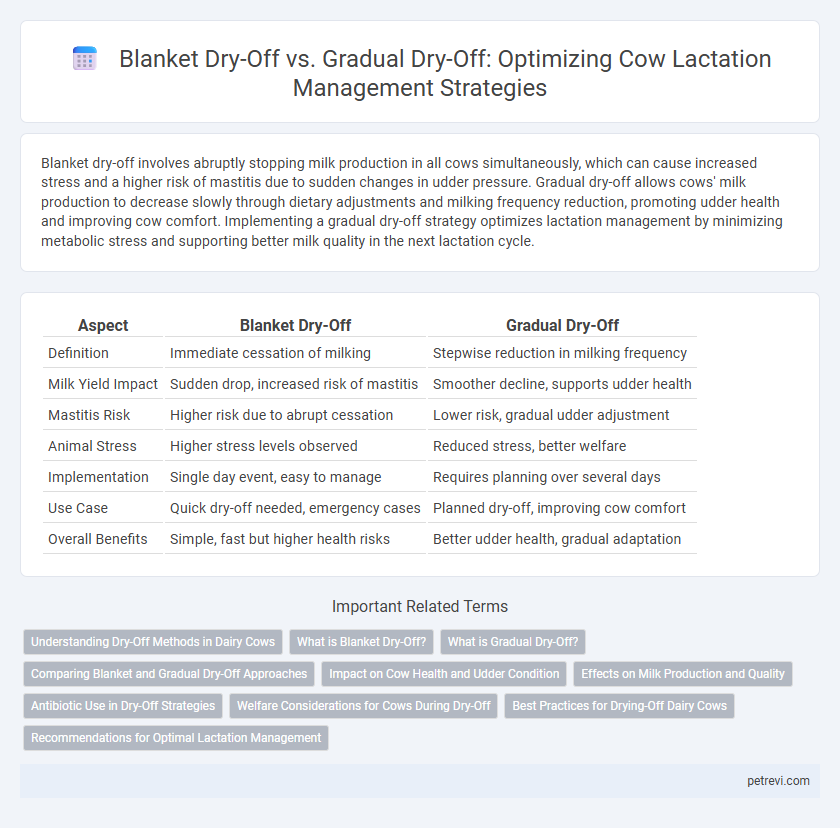Blanket dry-off involves abruptly stopping milk production in all cows simultaneously, which can cause increased stress and a higher risk of mastitis due to sudden changes in udder pressure. Gradual dry-off allows cows' milk production to decrease slowly through dietary adjustments and milking frequency reduction, promoting udder health and improving cow comfort. Implementing a gradual dry-off strategy optimizes lactation management by minimizing metabolic stress and supporting better milk quality in the next lactation cycle.
Table of Comparison
| Aspect | Blanket Dry-Off | Gradual Dry-Off |
|---|---|---|
| Definition | Immediate cessation of milking | Stepwise reduction in milking frequency |
| Milk Yield Impact | Sudden drop, increased risk of mastitis | Smoother decline, supports udder health |
| Mastitis Risk | Higher risk due to abrupt cessation | Lower risk, gradual udder adjustment |
| Animal Stress | Higher stress levels observed | Reduced stress, better welfare |
| Implementation | Single day event, easy to manage | Requires planning over several days |
| Use Case | Quick dry-off needed, emergency cases | Planned dry-off, improving cow comfort |
| Overall Benefits | Simple, fast but higher health risks | Better udder health, gradual adaptation |
Understanding Dry-Off Methods in Dairy Cows
Blanket dry-off involves abruptly ceasing milking for all cows at once, which can increase the risk of mastitis and negatively impact udder health due to sudden milk accumulation. Gradual dry-off reduces milking frequency or lowers feed intake incrementally, promoting udder involution and minimizing stress for dairy cows. Studies indicate gradual dry-off improves somatic cell count and enhances overall lactation performance in subsequent milk cycles.
What is Blanket Dry-Off?
Blanket dry-off is a standard practice in cow lactation management where all cows are dried off simultaneously at the end of their lactation period, typically around 60 days before calving. This method involves ceasing milk production abruptly by stopping milking and applying dry cow therapy to prevent mastitis and promote udder health. Blanket dry-off is widely used for its simplicity and effectiveness in managing dry periods but may increase stress and risk of metabolic disorders compared to gradual dry-off techniques.
What is Gradual Dry-Off?
Gradual dry-off in cow lactation management involves slowly reducing milk production over a period, allowing the udder to adapt and minimizing stress on the cow. This method contrasts with blanket dry-off, where milking stops abruptly, potentially increasing the risk of mastitis and discomfort. Research shows gradual dry-off improves udder health and enhances cow welfare during the transition period.
Comparing Blanket and Gradual Dry-Off Approaches
Blanket dry-off involves ceasing milking abruptly, which can increase the risk of udder discomfort and mastitis compared to gradual dry-off methods that taper milking frequency or reduce feed to decrease milk production safely. Gradual dry-off supports better udder health by allowing the cow's glandular tissue to adjust, reducing bacterial infections and promoting tissue regeneration. Studies indicate that gradual dry-off can improve cow welfare and future lactation performance compared to the stress caused by abrupt blanket dry-off.
Impact on Cow Health and Udder Condition
Blanket dry-off in cow lactation management often leads to increased stress on udder tissue and a higher risk of mastitis due to abrupt cessation of milking, whereas gradual dry-off promotes a smoother transition by slowly reducing milk yield and minimizing inflammation. Studies show that gradual dry-off supports better udder condition by maintaining teat canal integrity and reducing bacterial colonization, improving overall cow health during the dry period. Optimal dry-off protocols enhance immune response and decrease somatic cell count, crucial factors for maintaining udder health and maximizing subsequent lactation performance.
Effects on Milk Production and Quality
Blanket dry-off abruptly stops milking, often leading to a sharp decline in milk production and increased risk of mastitis due to sudden udder pressure changes. Gradual dry-off reduces milking frequency over 7 to 14 days, promoting better udder health, maintaining milk quality, and minimizing somatic cell count elevations. Studies show that gradual dry-off techniques preserve milk yield in subsequent lactations and improve overall lactation performance by allowing cows to adjust physiologically.
Antibiotic Use in Dry-Off Strategies
Blanket dry-off involves administering antibiotics to all cows simultaneously, ensuring comprehensive infection control but increasing antibiotic use and risk of resistance. Gradual dry-off targets only cows with existing infections, reducing overall antibiotic application while maintaining udder health and minimizing antimicrobial resistance. Optimal lactation management balances infection prevention with responsible antibiotic stewardship to enhance dairy herd health.
Welfare Considerations for Cows During Dry-Off
Blanket dry-off, which involves abruptly stopping milking for all cows, can increase stress and discomfort due to sudden milk accumulation and increased risk of mastitis, negatively affecting cow welfare. Gradual dry-off, by slowly reducing milk yield over several days, promotes better udder health and reduces behavioral signs of pain, enhancing overall comfort during the transition. Effective welfare management during dry-off prioritizes minimizing physiological stress and maintaining udder integrity to support cow well-being and productivity.
Best Practices for Drying-Off Dairy Cows
Blanket dry-off involves abruptly ceasing milking all cows simultaneously, which can increase the risk of mastitis and reduce udder health, whereas gradual dry-off incrementally reduces milking frequency, promoting better udder recovery and minimizing stress. Research indicates that gradual dry-off, including decreasing milking sessions and modifying diet to lower milk yield before dry-off, enhances cow comfort and improves colostrum quality for the next lactation. Implementing gradual dry-off protocols with attention to hygiene, teat sealing, and proper nutrition supports optimal dry period length and overall dairy herd productivity.
Recommendations for Optimal Lactation Management
Gradual dry-off is recommended for optimal lactation management to reduce the risk of mastitis and improve udder health by slowly decreasing milk production before the dry period. Blanket dry-off can be used but increases udder pressure and stress, potentially leading to higher infection rates and decreased milk yield in the subsequent lactation. Implementing cow-specific drying strategies based on lactation stage and milk yield ensures better animal welfare and milk quality outcomes.
Blanket dry-off vs Gradual dry-off for Cow lactation management Infographic

 petrevi.com
petrevi.com